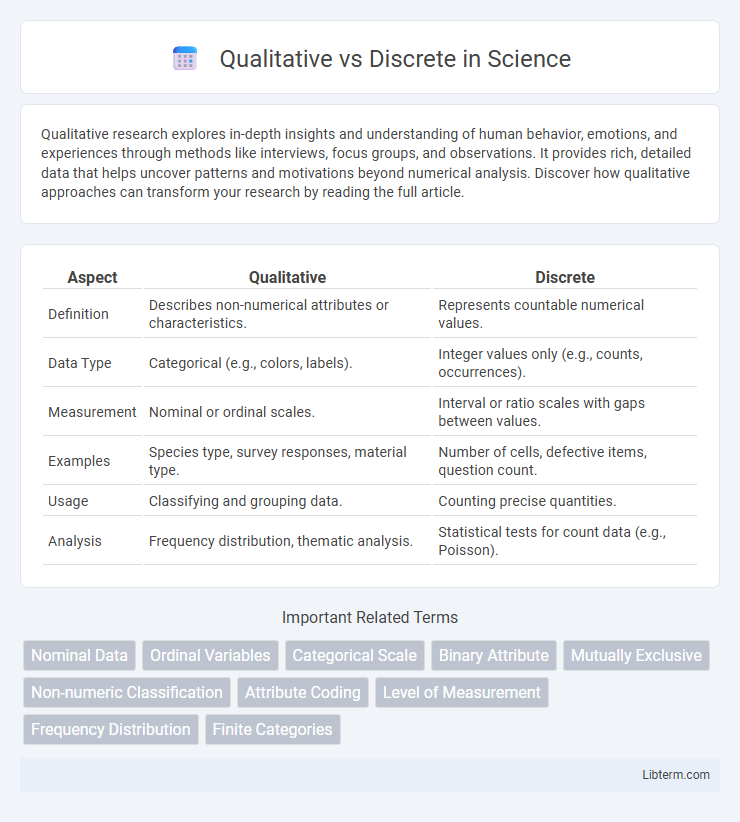Qualitative research explores in-depth insights and understanding of human behavior, emotions, and experiences through methods like interviews, focus groups, and observations. It provides rich, detailed data that helps uncover patterns and motivations beyond numerical analysis. Discover how qualitative approaches can transform your research by reading the full article.
Table of Comparison
| Aspect | Qualitative | Discrete |
|---|---|---|
| Definition | Describes non-numerical attributes or characteristics. | Represents countable numerical values. |
| Data Type | Categorical (e.g., colors, labels). | Integer values only (e.g., counts, occurrences). |
| Measurement | Nominal or ordinal scales. | Interval or ratio scales with gaps between values. |
| Examples | Species type, survey responses, material type. | Number of cells, defective items, question count. |
| Usage | Classifying and grouping data. | Counting precise quantities. |
| Analysis | Frequency distribution, thematic analysis. | Statistical tests for count data (e.g., Poisson). |
Introduction to Qualitative and Discrete Data
Qualitative data represents non-numeric information that categorizes attributes or characteristics, such as colors, names, or labels, and is essential for identifying patterns or themes in research. Discrete data consists of countable numerical values, often whole numbers, that quantify specific occurrences like the number of students or cars, allowing for precise measurement and statistical analysis. Understanding the distinction between qualitative and discrete data is crucial for selecting appropriate methods for data collection, analysis, and interpretation in various fields including social sciences and business analytics.
Defining Qualitative Data
Qualitative data refers to non-numerical information that captures characteristics, attributes, or categories, such as colors, labels, or opinions. It is used to describe qualities or features that cannot be measured with numbers but can be observed and recorded. This type of data plays a crucial role in understanding subjective experiences and contextual details within research and analysis.
Understanding Discrete Data
Discrete data represents distinct, countable values often used to categorize information into specific groups or categories. Understanding discrete data involves recognizing its non-continuous nature, where values are whole numbers such as the number of students in a class or the number of defective items in a batch. This type of data is essential for statistical analysis in fields like quality control, market research, and inventory management, where precise counts impact decision-making processes.
Key Differences Between Qualitative and Discrete Data
Qualitative data represents categorical information such as colors, labels, or characteristics, and is non-numeric in nature, whereas discrete data consists of countable numerical values with distinct, separate units like the number of students or cars. Key differences lie in data type, where qualitative data is descriptive and discrete data is quantitative; qualitative cannot be measured numerically but discrete data can be counted and mathematically manipulated. The level of measurement is nominal or ordinal for qualitative data and ratio or interval for discrete data, influencing appropriate statistical analysis techniques used for each.
Examples of Qualitative Data
Examples of qualitative data include categories such as gender, hair color, and marital status, which represent non-numerical characteristics that describe attributes or qualities. These data types contrast with discrete quantitative data, which consist of countable numerical values like the number of siblings or cars. Qualitative data provide essential insights in fields like market research, psychology, and sociology by capturing subjective information and patterns that numbers alone cannot convey.
Examples of Discrete Data
Discrete data consists of countable, distinct values such as the number of students in a class, the number of cars in a parking lot, or the number of goals scored in a soccer match. Unlike qualitative data that categorizes non-numeric attributes like colors or types of fruits, discrete data specifically measures quantifiable items that cannot be subdivided meaningfully. Common examples include the number of siblings in a family, the tally of books on a shelf, and the count of defective products in a batch.
Methods for Collecting Qualitative Data
Methods for collecting qualitative data include interviews, focus groups, and participant observations, which enable researchers to gather in-depth insights and understand participants' perspectives. Open-ended questionnaires and case studies also provide rich, detailed information beyond numerical values. These techniques emphasize context and meaning, differentiating qualitative approaches from discrete data collection that relies on countable and categorical variables.
Techniques for Analyzing Discrete Data
Techniques for analyzing discrete data include frequency distribution, mode calculation, and the use of contingency tables to summarize categorical variables. Statistical tests such as the Chi-square test and Fisher's exact test assess independence or association between discrete variables. Data visualization methods like bar charts and pie charts effectively represent discrete data patterns for clearer interpretation.
Applications in Research and Real-World Scenarios
Qualitative data, often collected through interviews, focus groups, and observations, provides in-depth insights into behaviors, motivations, and experiences, making it essential for exploratory research and understanding complex phenomena in social sciences. Discrete data, characterized by countable, distinct values such as the number of patients diagnosed or survey responses, is crucial for statistical analysis, quantitative research, and decision-making in fields like epidemiology, market research, and quality control. Both data types complement each other by enabling researchers to analyze patterns and generate actionable conclusions across various real-world scenarios.
Choosing Between Qualitative and Discrete Data
Choosing between qualitative and discrete data depends on the nature of the research question and data requirements. Qualitative data captures descriptive attributes and patterns, suitable for understanding perceptions and experiences, while discrete data involves countable, numerical values ideal for statistical analysis and quantifying phenomena. Selecting the appropriate type ensures accurate data collection and meaningful insights in fields like market research, social sciences, or data analytics.
Qualitative Infographic

 libterm.com
libterm.com